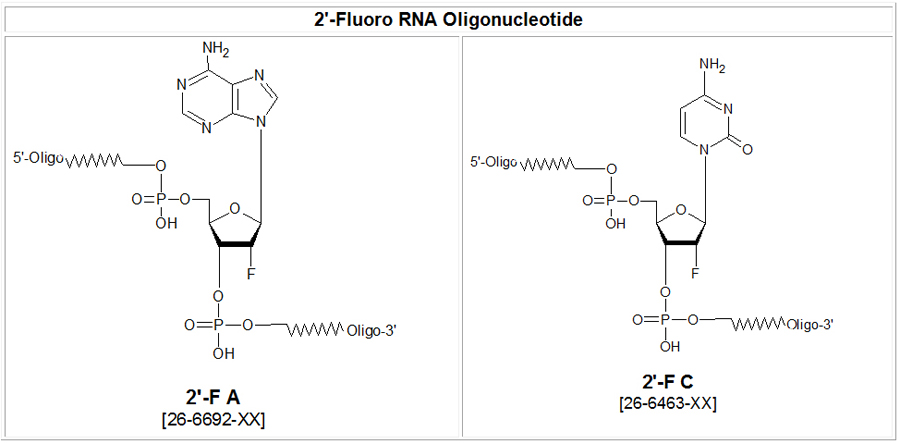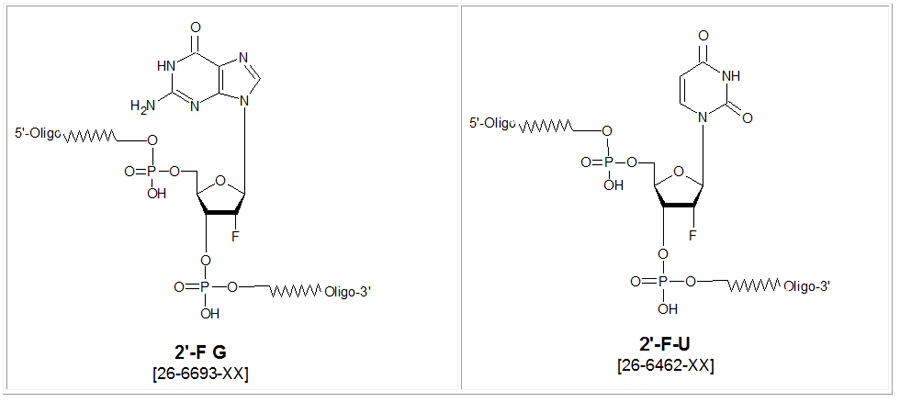
Duplex Stability and Nuclease Resistance |
2′-Deoxy-2′-fluoro-nucleosides adopt an RNA-type sugar conformation, presumably due to the high electronegativity of fluorine. Because of this sugar conformation, RNA duplexes (A-form) are generally more thermodynamically stable than DNA duplexes (B-form). As expected, the addition of 2′-F-RNA residues to oligodeoxynucleotides progressively increases the thermal stability of their duplexes with RNA. The stabilization is additive at approximately 2° per residue. This compares favorably with 2′-OMe-RNA at around 1.5° and RNA at 1.1° per residue. In the meantime, base pair specificity remains intact.
2′-F-RNA phosphodiester linkages are not nuclease resistant, although the corresponding phosphorothioate linkages are highly resistant. Researchers usually design antisense oligonucleotides to form duplexes with RNA, which are then substrates for RNase H. Uniformly modified 2′-F-RNA/RNA duplexes are not substrates for RNase H. However, it is straightforward to prepare chimeric 2′-F-RNA/DNA phosphorothioate oligonucleotides which exhibit enhanced binding to the RNA target, are substrates for RNase H, and are highly nuclease resistant.
Fluorine has an interesting combination of properties, combining electronegativity similar to a hydroxyl group with size between an oxygen and a hydrogen atom. This combination leads to the ring of a 2′-F-ribonucleoside adopting a C3′-endo conformation and the resulting 2′-F-RNA oligonucleotide adopts an A-form helix on hybridization to a target. Indeed, circular dichroism (CD) spectra of 2′-F-RNA/RNA duplexes indicate that they are A-form and that the sugars have all adopted the C3′-endo pucker. An important difference between RNA and 2′-F-RNA is that a hydroxyl group is a hydrogen bond donor while fluorine is a weak acceptor.
In studying antisense oligonucleotides, a group at Isis Pharmaceuticals concluded that oligonucleotides hybridized to a target RNA oligonucleotide in the following order of increasing stability: DNA < RNA < 2′-OMe-RNA < 2′-F-RNA. With an RNA target, melting temperature (Tm) was enhanced relative to an antisense DNA oligonucleotide by 1°C per residue for RNA, 1.3 °C for 2′-OMe-RNA, and 1.8 °C for 2′-F-RNA. The stability enhancement for 2′-F-RNA hybridizing to an RNA target was additive for each 2′-F-RNA residue and slightly cooperative – i.e., the DTm per substitution increases as more 2′-F-RNA residues are incorporated into the oligonucleotide. This has led to the use of 2′-F–RNA in aptamers since the resulting aptamers are not only more resistant to nucleases compared to 2′-OH RNA aptamers, but also bind ligands with higher affinities. The use, however, of 2′-F-RNA in antisense applications is limited since the 2′-F-RNA exhibits little enhanced nuclease resistance compared to DNA and its hybrid duplex does not activate RNase-H.


It has been demonstrated that siRNA synthesized with 2′-F pyrimidines showed greatly increased stability in human plasma compared to 2′-OH siRNA. They were functional in cell culture and in vivo using BALB/c mice transfected with pGL3 luciferase. Interestingly, though the 2′-F siRNA was significantly more stable than 2′-OH siRNA, they were only slightly more inhibitory over time in cell culture than 2′-OH siRNA; in vivo, their activities were practically the same. The authors note that these results may depend upon the siRNA delivery methodology. Less has been reported on the stability of duplexes between 2′-F-RNA and DNA. The cleavage of RNA/DNA duplexes by RNase H, 2′-F-Adenosine (2′-F-A) oligonucleotides and chimeras containing 2′-F-A and rA were used to evaluate the ability of the modified RNA strand to promote varying levels of RNase-H activity. The authors measured the Tm of 18-mer oligonucleotides containing rA and/or 2′-F-A to oligo-T18 and found that the homopolymer of 2′-F-A enhanced binding by 0.5° per residue relative to rA. However, chimeras of 2′-F-RNA and rA were unpredictable in their melting behavior and some actually lowered the duplex Tm. Glen Research melting experiments of duplexes containing 2′-F-RNA supported these results. They found that a single substitution of 2′-F-RNA in a mixed base DNA/DNA dodecamer increased the Tm by 1.2 °C. However, further substitutions with two or four 2′-F-RNA residues led to a drop in the Tm by 1.3 °C. Interestingly, a fully substituted 2′-F-RNA/DNA duplex does exhibit higher stability, with the Tm being increased by 0.5° per incorporation.